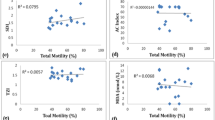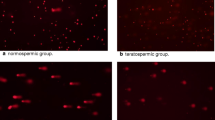Abstract
Purpose
To find a relationship between absence of annulus and asthenozoospermia in Iranian men.
Methods
In the present study, semen samples from 100 asthenozoospermic and 20 normozospermic patients were analyzed for sperm concentration and motility. Spermatozoa were immunostained for the two septin subunits Sept4 and Sept7. The absence of the annulus structure was confirmed by transmission electron microscopy and western blot analysis for septin 4. DNA sequencing for all coding exons of SEPT12 was performed for a patient using peripheral blood sample.
Results
Specific antibodies for SEPT4 and SEPT7 consistently labeled the annuli in spermatozoa from all of the 20 normozospermic men, while in one of 100 patients with asthenozoospermia, 75 % of sperms lacking septin 4 or septin 7 proteins at the annulus. It was shown that the structural defect in annulus formation is not caused by point mutation of SEPT12 gene.
Conclusions
In conclusion, the results of this study demonstrated that the frequency of the absence of annulus in asthenozoospermic sample of Iranian population has a low frequency and could not be assume as a diagnostic marker for classifying asthenozoospermic patients.




Similar content being viewed by others
References
Sugino Y, Ichioka K, Soda T, Ihara M, Kinoshita M. Septins as diagnostic markers for a subset of human asthenozoospermia. Urology. 2008;180:2706–9. doi:10.1016/j.juro.2008.08.005.
Kwitny S, Klaus AV, Hunnicutt GR. The annulus of the mouse sperm tail is required to establish a membrane diffusion barrier that is engaged during the late steps of spermiogenesis. Biol Reprod. 2010;82(4):669–78. doi:10.1095/biolreprod.109.079566.
Cao L, Ding X, Yu W, Yang X, Shen S, Yu L. Phylogenetic and evolutionary analysis of the septin protein family in metazoan. FEBS Lett. 2007;581(28):5526–32. doi:10.1016/j.febslet.2007.10.032.
Estey MP, Di Ciano-Oliveira C, Froese CD, Bejide MT, Trimble WS. Distinct roles of septins in cytokinesis: SEPT9 mediates midbody abscission. J Cell Biol. 2010;191(4):741–9. doi:10.1083/jcb.201006031.
Schmidt K, Nichols BJ. Functional interdependence between septin and actin cytoskeleton. BMC Cell Biol. 2004;5(1):43. doi:10.1186/1471-2121-5-43.
Lin YH, Lin YM, Wang YY, Yu IS, Lin YW, Wang YH, et al. The expression level of septin12 is critical for spermiogenesis. Am J Pathol. 2009;174(5):1857–68. doi:10.2353/ajpath.2009.080955.
Ihara M, Kinoshita A, Yamada S, Tanaka H, Tanigaki A, Kitano A, et al. Cortical organization by the septin cytoskeleton is essential for structural and mechanical integrity of mammalian spermatozoa. Dev Cell. 2005;8(3):343–52. doi:10.1016/j.devcel.2004.12.005.
Kissel H, Georgescu MM, Larisch S, Manova K, Hunnicutt GR, Steller H. The Sept4 septin locus is required for sperm terminal differentiation in mice. Dev Cell. 2005;8(3):353–64. doi:10.1016/j.devcel.2005.01.021.
World Health Organization. WHO laboratory manual for the examination and processing of human semen. Cambridge: Cambridge University Press; 2010.
Lhuillier P, Rode B, Escalier D, Lores P, Dirami T, Bienvenu T, et al. Absence of annulus in human asthenozoospermia: case report. Hum Reprod. 2009;24(6):1296–303. doi:10.1093/humrep/dep020.
Lin YH, Chou CK, Hung YC, Yu IS, Pan HA, Lin SW, et al. SEPT12 deficiency causes sperm nucleus damage and developmental arrest of preimplantation embryos. Fertil Steril. 2011;95(1):363–5. doi:10.1016/j.fertnstert.2010.07.1064.
Weirich CS, Erzberger JP, Barral Y. The septin family of GTPases: architecture and dynamics. Nat Rev Mol Cell Biol. 2008;9(6):478–89. doi:10.1038/nrm2407.
Chao HC, Lin YH, Kuo YC, Shen CJ, Pan HA, Kuo PL. The expression pattern of SEPT7 correlates with sperm morphology. J Assist Reprod Genet. 2010;27(6):299–307. doi:10.1007/s10815-010-9409-4.
Miyakawa H, Miyamoto T, Koh E, Tsujimura A, Miyagawa Y, Saijo Y et al. Single-nucleotide polymorphisms in the SEPTIN12 gene may be a genetic risk factor for Japanese patients with Sertoli cell-only syndrome. J Androl. doi:10.2164/jandrol.110.012146.
Lin YH, Wang YY, Chen HI, Kuo YC, Chiou YW, Lin HH, et al. SEPTIN12 genetic variants confer susceptibility to teratozoospermia. PLoS One. 2012;7(3):e34011. doi:10.1371/journal.pone.0034011.
Kuo YC, Lin YH, Chen HI, Wang YY, Chiou YW, Lin HH, et al. SEPT12 mutations cause male infertility with defective sperm annulus. Hum Mutat. 2012;33(4):710–9. doi:10.1002/humu.22028.
Author information
Authors and Affiliations
Corresponding author
Additional information
Capsule Absence of annulus has been reported in some of asthenozoospermic patients but its frequency in Iranian infertile men is low.
Rights and permissions
About this article
Cite this article
Hosseinifar, H., Shafipour, M., Modarresi, T. et al. Relationship between absence of annulus and asthenozoospermia in Iranian men. J Assist Reprod Genet 31, 1681–1685 (2014). https://doi.org/10.1007/s10815-014-0353-6
Received:
Accepted:
Published:
Issue Date:
DOI: https://doi.org/10.1007/s10815-014-0353-6




